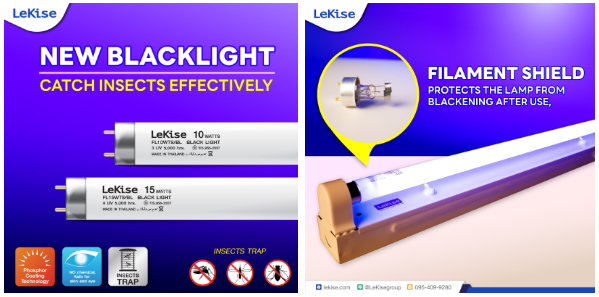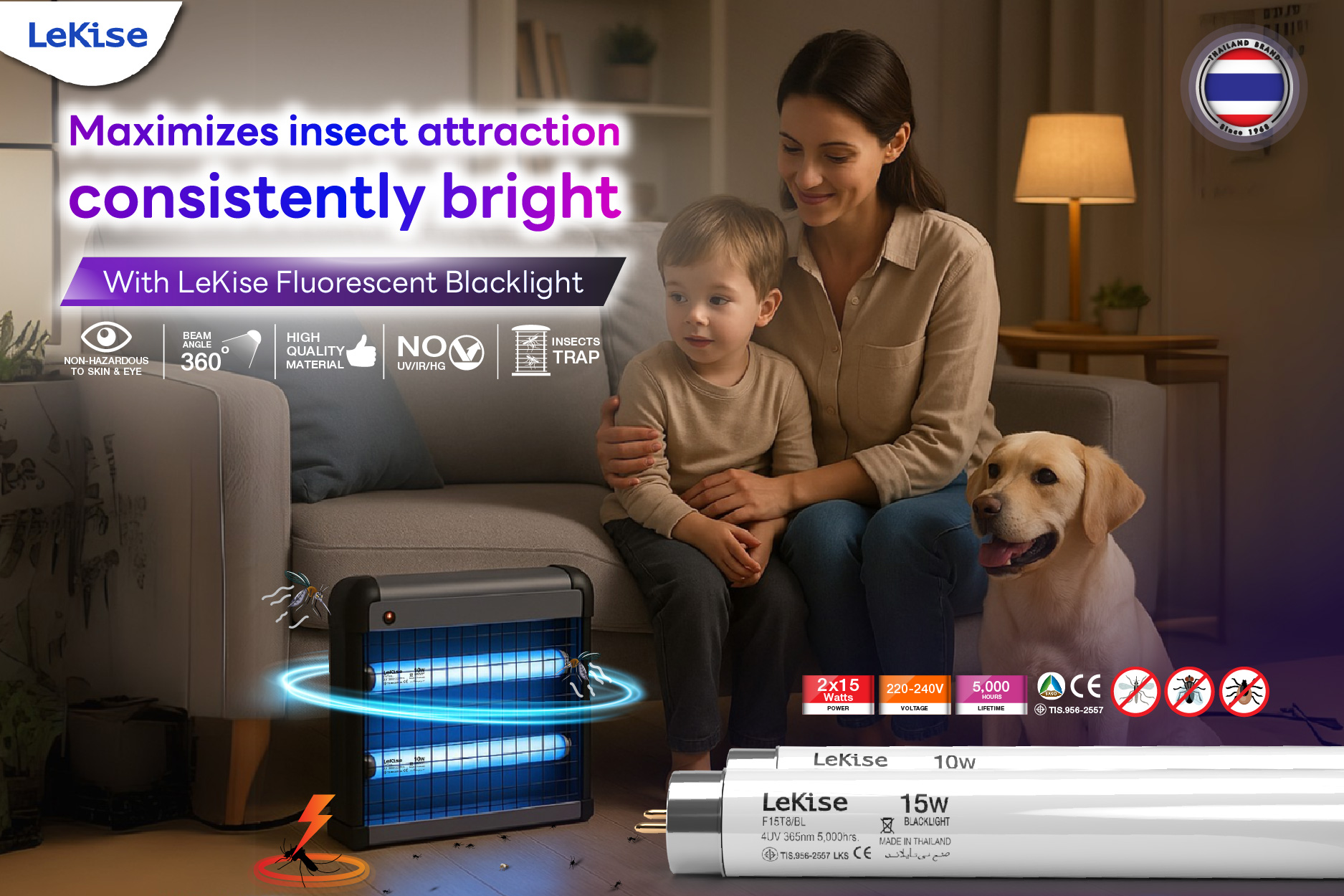LeKise Fluorescent Blacklight maximizes insect attraction, consistently bright
Fluorescent Blacklight bulbs are popularly used in a variety of places. They have a distinctive purple or blue-purple light. However, despite their wide range of uses, one of the problems that many users often encounter is that the bulbs "deteriorate abnormally quickly", which is mainly caused by black soot at the end of the bulb. Although this problem may seem minor, if you do not understand the cause and how to fix it, you may have to change the bulb frequently. So what causes the black soot at the end of the bulb? How does it affect the bulb's performance? And how can we solve this problem? This article will help you find the answers and introduce you to the two popular types of Fluorescent Blacklight bulbs.1. Blacklight Blue (BLB)
It is coated with a filter that emits only ultraviolet (UV-A) radiation and very little visible light. It usually emits a deep purple or blue-purple light. The tube is made of Wood's Glass (dark purple black). It is popularly used for applications that require objects to glow, such as disco lights, neon art, checking counterfeit banknotes, forensic science, and the luminescence of certain substances, etc.
2. Blacklight tube (BL - Blacklight)
Uses clear glass coated with phosphor. There is no light filtering coating like Blacklight Blue (BLB) tubes. Therefore, it does not filter visible light. The light emitted is bluish-white. And still emits UV-A rays. It is popularly used in mosquito and insect traps or general industries.
What is soot at the end of the tube?
Soot at the end of the tube is a black stain that appears at the end of the tube after being used for a while. It is a sign of the deterioration of the bulb. Soot is clearly visible in clear glass tubes such as Blacklight (BL) tubes. However, it is harder to see in Blacklight Blue (BLB) tubes that use dark purple glass tubes. Therefore, it can be checked by turning on the tube in a dark place and observing the light at the end of the tube or looking from the side. If the light decreases, it may indicate that there is a build-up of soot at the tube.
Causes of black soot
Black soot is not caused by external dirt, but from inside the bulb itself. The main cause is the deterioration of the important components in the bulb, including:
1. Electrode
When the bulb is working, an electric current flows through both electrodes, causing heat and causing the electrodes to gradually deteriorate. Over time, some of the metal from the electrodes evaporates and precipitates into black deposits at the end of the bulb.
2. Phosphor
The coating inside the bulb that emits light when it receives energy can also deteriorate, especially in areas near the electrodes, which are the areas with the highest heat. Therefore, there is a chance that it will burn or combine with other particles, turning into black soot.
How does black soot affect bulbs?
1. Reduced light output
Black soot that accumulates on the bulb can reduce and make the emitted light inconsistent. When more soot accumulates until the light is fully distributed, it affects the light in that area. It decreases and may cause the surrounding atmosphere to look darker.
2. Reduced efficiency in attracting mosquitoes and insects
Fluorescent blacklight bulbs emit light in the UV-A wavelength range, which is the wavelength range that mosquitoes and some insects are particularly sensitive to. Therefore, they are often used in mosquito traps or insect lamps. However, if there is black soot accumulated on the surface of the bulb, the emitted UV light will be absorbed or reflected, reducing the light intensity, resulting in a decrease in the efficiency in attracting mosquitoes.
3. Reduced service life
Black soot not only causes the bulb to produce less light, but also affects the life of the bulb. The accumulation of black soot makes the bulb work harder and deteriorate faster, resulting in frequent bulb replacements, which wastes time and costs more. In addition, frequent bulb replacement is a maintenance burden that is not worthwhile in the long run.
.
How does LeKise Fluorescent Blacklight solve the problem of black soot?
LeKise has recognized this problem and developed a Fluorescent Blacklight that comes with Filament Shield technology, which is a special protective filter that wraps around the electrodes.

LeKise has recognized this problem and developed a Fluorescent Blacklight that comes with Filament Shield technology, which is a special protective filter that wraps around the electrodes.
Benefits of Filament Shield
1. Reduces the accumulation of soot
Prevents soot in the bulb by controlling the direction of gas and metal evaporation to prevent it from sticking to the bulb surface, reducing black stains that make the light dull and helping the bulb to shine at its fullest.
2. Extends the lifespan and reduces long-term costs
Helps protect the bulb from many factors that can cause it to deteriorate quickly, such as heat from continuous use, dust or soot accumulated from combustion. Bulbs with Filament Shield help extend the lifespan, eliminating the need to change bulbs often, and reducing the cost of buying new bulbs.
3. Maintains the quality of UV light
Filament Shield acts as a barrier, helping to trap these metal particles, preventing them from interfering with UV light emission, allowing the Fluorescent Blacklight to continue to provide strong and clear UV rays.
From the above article, it can be seen that “soot at the end of the bulb” is a warning sign of blacklight bulb deterioration, which affects its efficiency. This problem can be prevented with Fluorescent Blacklight bulbs with Filament Shield from a reliable company like LeKise because we care about every step of the production process to ensure that you receive good and high-quality products. Under the ISO:9001 factory standard and with a reputation for over 55 years in the lighting industry, LeKise professional team is ready to help promote your business with high-quality and reliable lighting products.
Precautions for using Fluorescent Blacklight safely Since blacklights are not as expensive as you think, blacklight bulbs that are created from UVA rays have been purchased for many other applications. However, if we are not careful, it can affect our skin. Therefore, we should be careful: we should strictly use the benefits of blacklight bulbs according to the manufacturer's instructions and we should not make our own blacklight bulbs because receiving UVA rays directly from blacklight bulbs that are not coated with phosphorus can cause skin irritation. Most importantly, when a bulb is broken, it should be disposed of properly by wrapping it in newspaper or putting it in the original bulb box to prevent breakage or leakage of mercury. Write a message indicating that the bulb is broken or damaged. Then, we should dispose of it at a hazardous waste collection point or in a red bin.
1. Reduces the accumulation of soot
Prevents soot in the bulb by controlling the direction of gas and metal evaporation to prevent it from sticking to the bulb surface, reducing black stains that make the light dull and helping the bulb to shine at its fullest.
2. Extends the lifespan and reduces long-term costs
Helps protect the bulb from many factors that can cause it to deteriorate quickly, such as heat from continuous use, dust or soot accumulated from combustion. Bulbs with Filament Shield help extend the lifespan, eliminating the need to change bulbs often, and reducing the cost of buying new bulbs.
3. Maintains the quality of UV light
Filament Shield acts as a barrier, helping to trap these metal particles, preventing them from interfering with UV light emission, allowing the Fluorescent Blacklight to continue to provide strong and clear UV rays.
From the above article, it can be seen that “soot at the end of the bulb” is a warning sign of blacklight bulb deterioration, which affects its efficiency. This problem can be prevented with Fluorescent Blacklight bulbs with Filament Shield from a reliable company like LeKise because we care about every step of the production process to ensure that you receive good and high-quality products. Under the ISO:9001 factory standard and with a reputation for over 55 years in the lighting industry, LeKise professional team is ready to help promote your business with high-quality and reliable lighting products.
Precautions for using Fluorescent Blacklight safely
Thinking of quality light, thinking of LeKise.
LeKise "One Stop Lighting Service"
We also warm welcome OEM Brands partners. Furthermore Please contact with our staff or send us inquiry here to get more updates.
Email: exportsales@lekise.co.th
PH: +66 34 419 299
or visit our company webpage www.lekise.com or subscribe our Social media channels;
Facebook: https://www.facebook.com/lekiseledlighting
YouTube: https://youtu.be/tmKQBqYloVo?si=yUJ2ibByFJm1I6cm
to get more further information about our company product and services on timely manners.






